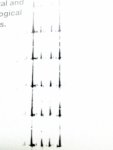dgraves8rd
Well-known member
Plate/Press issue - After washing up/gumming plates will sometimes leave a track mark that will not come off plate.
Press: Komori 540
Plates: Agfa Azura
We have been experiencing this issue and have not been able to figure it out. This doesn't happen all the time and not even on the same cylinder.
Pictures are attached.
Press: Komori 540
Plates: Agfa Azura
We have been experiencing this issue and have not been able to figure it out. This doesn't happen all the time and not even on the same cylinder.
Pictures are attached.













